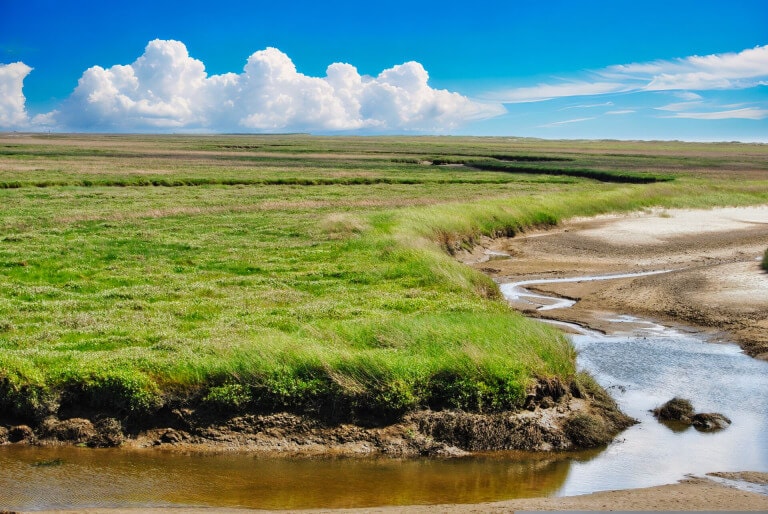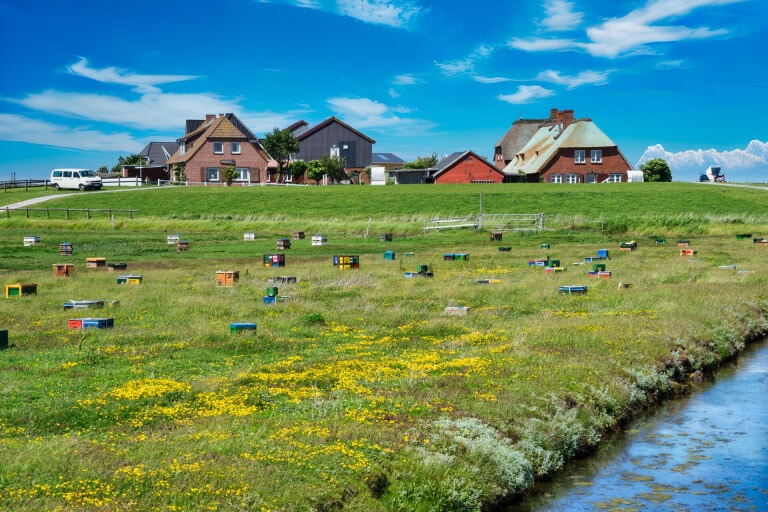Hamburger Hallig, also called Hamborg hallig in Danish and Hamborjer Håli in Frisian, is an un-diked peninsula on the west coast of North Frisia in Schleswig-Holstein. The name of the Hallig commemorates Rudolf and Arnold Amsinck, two Hamburg merchants who acquired dike rights on the northeast corner of Strand Island in 1624 and built dikes until 1628. This article gives an overview of the history, construction and current condition.
The history of the Hamburg Hallig
Amsinck-Koog was destroyed by the Burchardi flood in 1634. All that remained was the residential mound with the Hamburger Haus, which became a salvation for numerous inhabitants of Strand during the storm surge. After the Burchardi flood, the dikes were rebuilt at great expense and survivors of the flood were settled. Arnold Amsinck died in 1658 in the Hamburg house in his coog, having invested his entire fortune in the re-diking of the area. The house was demolished and replaced by a smaller house in 1661.
In 1711 the dikes were destroyed to such an extent that Amsinck-Koog was once again a Hallig. It remained in the possession of the Amsinck family until 1760. In 1781 the name Hamburger Hallig was mentioned for the first time. The house was destroyed by the February flood of 1825, and in 1855 plans were made for a connecting causeway to the mainland. The causeway was built in 1859/60, but broke again in 1860. In 1866/67, a brush dam was built from Bordelumersiel to the Hallig. This dam was reinforced in 1874 and received an overflow channel, which was closed in 1875. The interruption of the tidal currents passing through greatly accelerated siltation on both sides of the dam.
In 1878 the treasury bought it and from then on leased it for cultivation. In 1880 an artesian well was built. Since 1901 the dam has been passable. In 1928 it was incorporated into the municipality of Reußenköge. Today, together with the dike foreland of the Sönke-Nissen-Koog and the salt marshes, it covers around 1,000 hectares and is managed by the NABU nature conservation association.
Hamburg Hallig Structure
Hamburger Hallig has three terps, including a terp on the dike foreland and an unvegetated terp. The main dwelling mound lies four kilometers west of the sea dike of Sönke-Nissen-Koog and has no name of its own. There are three buildings on it: the Hallig Krog restaurant, which is operated from Easter (but no later than April 1) until October 31, a base of the NationalparkService gGmbH (NPS) with an apartment for interns (only temporarily occupied in summer), and the Watt workshop (exhibition and laboratory rooms of the NPS).
About 300 meters south of the main hill is the Kuhberg, a low, undeveloped hill that serves as a rescue mound for sheep during light land storms. Two kilometers to the east, about halfway to the mainland, is the Schafberg with the NABU station, the Claus-Jürgen Reitmann-Haus. The refuge is only temporarily occupied by NABU conservation volunteers. The Schafberg is located in the foreland in front of the Sönke-Nissen-Koog, i.e. not on the actual. Some sources therefore speak only of an inhabited hill.
Current status of the Hamburg Hallig
Hamburger has not been an island since it was connected to the mainland by a dike in 1860. Today it adjoins the dike foreland in front of the Sönke-Nissen-Koog and, like the latter, belongs to the municipality and district of Reußenköge. Until 1899 it was a municipality-free estate district. An area of 79 hectares was proven for the uninhabited manor district. Today, the western shore is largely secured against further land loss by fortification measures.
On April 16, 1930, this was declared a nature reserve to protect the avocet. The Nature and Biodiversity Conservation Union (NABU) manages the area, which covers around 1,000 hectares. The area is home to a variety of plant and animal species, including rare birds such as the great curlew and the shelduck. Visitors can experience the unique landscape and wildlife during guided tours and educational programs.
Conclusion
Amsinck-Koog was destroyed by the Burchardi flood in 1634. All that remained was the residential mound with the Hamburg House, which became a salvation for many residents of Strand during the storm surge. The area has a rich history and has been used for cultivation and nature conservation over the years. Today, it is a nature reserve managed by the NABU Nature Conservancy and is home to a variety of plant and animal species. Visitors can experience the unique landscape and wildlife through guided tours and educational programs.




